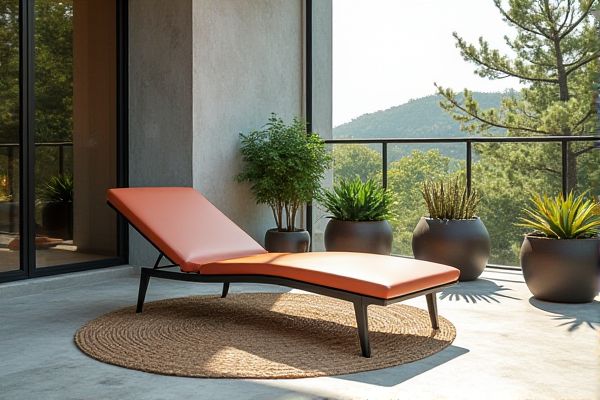
Plastic loungers offer lightweight convenience and weather resistance, making them ideal for easy maintenance on your terrace, while metal loungers provide superior durability and a sleek, modern aesthetic but may require more upkeep to prevent rust. Discover which lounger best suits your outdoor space needs by reading the full comparison in the rest of this article.
Table of Comparison
| Feature | Plastic Lounger | Metal Lounger |
|---|---|---|
| Material | Durable, lightweight plastic | Sturdy metal, often aluminum or steel |
| Weight | Lightweight, easy to move | Heavier, more stable |
| Durability | Resistant to rust and corrosion | High strength, prone to rust without coating |
| Maintenance | Low, easy to clean with water | Requires periodic treatment to prevent rust |
| Comfort | May need cushions for added comfort | Often sturdier, comfortable with cushions |
| Weather Resistance | Highly weather-resistant, UV stable | Weather-resistant if coated; metal may heat in sun |
| Price | Generally affordable | Usually higher cost |
Introduction to Plastic vs Metal Loungers for Terraces
Plastic loungers for terraces offer lightweight, weather-resistant options ideal for easy maintenance and portability, making them suitable for casual outdoor settings. Metal loungers, typically made from aluminum or steel, provide enhanced durability and a sturdy structure, often incorporating rust-resistant coatings to withstand various weather conditions. Choosing between plastic and metal loungers depends on factors like desired aesthetics, long-term durability, weight, and ease of cleaning.
Material Composition and Durability
Plastic loungers, typically made from high-density polyethylene or polypropylene, offer lightweight and weather-resistant properties with resistance to rust and corrosion, making them ideal for outdoor terrace use. Metal loungers, often composed of aluminum or steel, provide superior structural strength and longevity but require protective coatings to prevent rust and corrosion when exposed to outdoor elements. While plastic loungers excel in maintenance and portability, metal loungers deliver enhanced durability and load-bearing capacity for long-term terrace seating.
Weather Resistance and Maintenance Needs
Plastic loungers offer superior weather resistance due to their inherent resistance to moisture, UV rays, and rust, making them ideal for outdoor terraces with frequent exposure to sun and rain. Metal loungers, while durable and sturdy, require regular maintenance such as rust-proof coatings or paint to prevent corrosion and prolong lifespan in humid or wet conditions. Choosing plastic loungers reduces ongoing upkeep, whereas metal loungers need consistent care to maintain appearance and structural integrity over time.
Comfort and Ergonomic Design Differences
Plastic loungers offer lightweight comfort with flexible seating surfaces that adapt to body contours but may lack long-term support and breathability. Metal loungers provide robust ergonomic designs with adjustable reclining features and superior durability, enhancing posture support for extended outdoor use. The choice depends on preferred comfort level, with metal loungers favoring structural stability and plastic ones prioritizing portability.
Style and Aesthetics on Modern Terraces
Plastic loungers offer vibrant colors and sleek, lightweight designs that complement contemporary terrace aesthetics, allowing easy customization with cushions and covers. Metal loungers, often crafted from aluminum or wrought iron, provide a durable, industrial look with elegant finishes such as powder coating or brushed metal for modern outdoor spaces. Choosing between plastic and metal loungers depends on the desired balance of style, maintenance, and the overall terrace design theme.
Weight, Portability, and Storage
Plastic loungers are lightweight and easy to move, making them highly portable for your terrace relaxation needs. Metal loungers, while sturdier, tend to be heavier and less convenient to transport. Plastic loungers often offer the advantage of stackability for compact storage, whereas metal loungers may require more space and care to avoid rust or damage.
Environmental Impact and Sustainability
Plastic loungers often contribute to environmental pollution due to their non-biodegradable nature and reliance on fossil fuels during production, leading to prolonged landfill waste. Metal loungers, particularly those made from recyclable materials like aluminum or steel, tend to have a lower environmental impact as they can be recycled repeatedly and have a longer lifespan. Choosing your terrace lounger with sustainability in mind means prioritizing metal options for durability and reduced ecological footprint.
Pricing Comparison and Value for Money
Plastic loungers typically offer a budget-friendly option, making them more accessible for those seeking affordable terrace furniture without compromising basic comfort. Metal loungers, while often priced higher due to durable materials like aluminum or steel, provide enhanced longevity and sturdiness, delivering better long-term value for money. Your choice depends on balancing initial cost against durability and maintenance requirements for the best investment in terrace comfort.
User Experiences and Customer Reviews
Plastic loungers on terraces are praised for their lightweight design, easy maintenance, and affordability, making them ideal for frequent rearrangement and outdoor weather exposure. Metal loungers receive high marks for their durability, sturdiness, and modern aesthetics, though some users note they can heat up quickly in the sun and require occasional rust treatment. Customer reviews frequently highlight comfort differences, with plastic loungers being preferred for casual relaxation and metal loungers favored for long-term investment and structural reliability.
Conclusion: Choosing the Best Lounger for Your Terrace
Plastic loungers offer lightweight, weather-resistant convenience with easy maintenance, making them ideal for flexible terrace arrangements. Metal loungers provide superior durability, structural strength, and a sleek aesthetic suited for long-term investment and modern outdoor designs. Your decision depends on balancing portability and upkeep of plastic against the robustness and style of metal loungers for your terrace needs.
 homyna.com
homyna.com